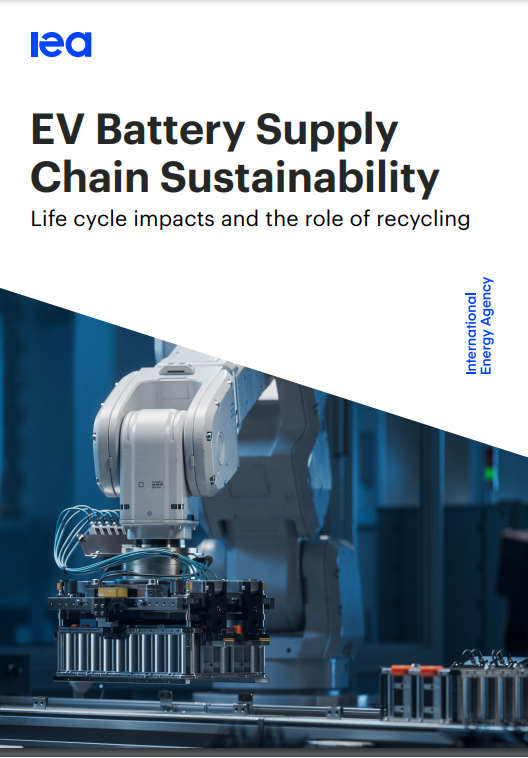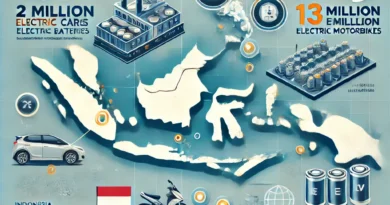Global Battery Demand Set to Skyrocket, Driven by Electric Vehicles
Global demand for batteries is projected to surge, increasing four-and-a-half times by 2030 and more than seven times by 2035, according to a new report from the International Energy Agency (IEA). The report, titled “EV Battery Supply Chain Sustainability,” highlights the crucial role of electric vehicles (EVs) and battery storage in this growing demand, while emphasizing the need for sustainable practices in the battery supply chain.
The report, published on December 2024, indicated that the rapid increase in battery demand is primarily driven by the growth in EV sales and battery storage installations.
In 2023, EVs accounted for almost 90% of the total battery demand, with electric cars representing about 80%. Although battery storage demand has also doubled in both 2022 and 2023, it started from a smaller base compared to EV battery demand.

The IEA’s analysis is based on current policy settings, and the projections could be even higher if countries fully achieve their climate and energy pledges.
“The role of emerging markets and developing economies (EMDEs) other than China is expected to grow significantly, reaching 10% of global battery demand by 2030, up from 3% in 2023,” the report states.
China currently dominates the battery market, accounting for about 55% of global demand in 2023, followed by the European Union and the United States, each with about 15%. However, the growth rate in the EU and the US exceeded the global average in 2023, with a 45% year-on-year increase, closely followed by China at 40%. Within the EMDEs, India accounts for almost one-third of battery demand.
Battery storage is also experiencing rapid growth, particularly in China, where demand nearly tripled in 2023. In the United States and the European Union, the battery storage market has also grown, albeit at a slower pace than in China.
According to the IEA report, the electrification strategies and pledges in EMDEs are boosting EV battery demand significantly. For example, India has committed to 100% sales of zero-emission light-duty vehicles by 2040, and Indonesia aims for 2 million electric cars and 13 million electric motorbikes by 2030.
The report further outlines that the share of EMDEs other than China in global battery demand is expected to more than triple by 2030. This will be primarily due to transport electrification strategies and pledges that boost EV battery demand. The popularity of two and three-wheeled vehicles in EMDEs means that the electrification of this sector will be an effective way to electrify a large proportion of road transport. Electrifying the entire fleet of 2/3-wheelers in India and Southeast Asia would require only 30% of the batteries needed to electrify their current car fleets.
The IEA report warns that the projected surge in demand underscores the importance of addressing the sustainability of the EV battery supply chain. The report also notes that if countries meet their climate and energy pledges, battery demand could increase even more significantly, multiplying by five times in 2030 and nine times in 2035. In a scenario consistent with the energy sector reaching net-zero emissions by 2050, the demand is projected to increase seven times in 2030 and 12 times in 2035. In fact, by 2035, weekly battery demand could exceed the total demand of 2019.
To meet this rapidly growing demand, the report stresses the importance of adequate infrastructure such as chargers, battery-swapping stations, and flexible electricity grids, along with sustainable and circular practices for battery production and use.
Frequently Asked Questions on EV Battery Supply Chain Sustainability
- How rapidly is the demand for EV batteries projected to grow, and what regions are expected to see the most significant increases?
Battery demand is expected to increase dramatically, growing four-and-a-half times by 2030 and more than seven times by 2035 based on current policy settings. Emerging Markets and Developing Economies (EMDEs), excluding China, are predicted to play a larger role, increasing their share of global demand from 3% in 2023 to 10% by 2030, with further growth if countries meet their climate pledges. Battery production is also expected to diversify with increased investment in Europe and North America, and potentially more production in EMDEs outside of China if climate pledges are met.
- How do the life cycle emissions of electric vehicles (EVs) compare to those of internal combustion engine vehicles (ICEVs)?
On a global average, the life cycle emissions of a medium-sized battery electric car are about half of those of an equivalent ICEV. The actual emissions difference varies by region, with greater savings in places like the UK and Chile (over 60% reduction) due to lower electricity emissions intensity and more efficient ICEVs, and less in India (around 20%) due to a less decarbonized grid. These emissions savings are expected to increase as electricity grids become cleaner.
- What role do battery-related emissions play in the overall life cycle emissions of EVs, and how can these emissions be reduced?
While not the largest contributor, battery-related emissions are a significant portion of EV life cycle emissions, especially concerning the production and processing of critical minerals. These emissions are projected to decline further through electrification of production processes, increased battery energy density, and the use of recycled materials. Strategies to lower battery emissions include sourcing less carbon-intensive critical minerals, improving processing efficiency, and utilizing cleaner energy sources in manufacturing.
- Why is battery recycling considered crucial for the sustainability of the EV industry, and what impact can it have on the demand for critical minerals?
Battery recycling is critical because it reduces the demand for newly mined critical minerals and lowers overall battery life cycle emissions. Recycling will be crucial to recover materials from manufacturing scrap over the next decade and from end-of-life batteries after 2035. If recycling is scaled effectively, it can potentially reduce the demand for lithium and nickel by 25% and for cobalt by 40% by 2050 in a scenario that meets climate goals. Scaling up recycling facilities and increasing collection rates of end-of-life batteries is essential.
- What are the main differences between lithium-ion battery chemistries (NMC and LFP) and how do these differences affect life cycle emissions?
The two main chemistries are Nickel Manganese Cobalt (NMC) and Lithium Iron Phosphate (LFP). NMC batteries, primarily used in Europe and the US, offer higher energy density but have a higher mineral-intensity and are more expensive to manufacture. LFP batteries, dominant in China, are less mineral-intensive and cheaper, while having better safety and longevity. The key emissions difference is that NMC batteries have higher emissions due to the critical mineral processing, especially with Nickel, while LFP emissions are more closely tied to cell manufacturing and electricity consumption during production. The life cycle emissions of both are set to improve as energy density and use of recycled materials increases, along with a decarbonization of grids.
- How can the export of second-hand electric vehicles impact global recycling efforts, and what strategies can be implemented to ensure sustainable practices?
The export of second-hand EVs can impact recycling efforts by potentially shifting end-of-life batteries to regions that may not have the necessary recycling infrastructure. A higher export rate may give emerging economies access to cheaper electric vehicles but can delay material recovery until a later date, especially since batteries are assumed to have a longer lifespan in these regions. International cooperation is essential to facilitate second-hand EV trade, ensuring that there are adequate recycling strategies at the destination countries, or, alternatively, implementing a system to return batteries when they finally reach end-of-life.
- What are some of the key policies and initiatives being implemented or considered to support battery sustainability and circularity, and what are some of the advantages and disadvantages?
The EU Batteries Regulation introduces mandates for recycled content, minimum recycling efficiency, and due diligence for raw material sourcing, creating market certainty for recycled materials, incentivizing sustainable design, and improving traceability through battery passports. One risk of this policy is the potential lack of enough feedstock to meet these targets due to longer EV lifespans, or second-hand exports. The Global Battery Passport initiative aims to provide a universal framework for tracking battery manufacturing, provenance and ESG performance, aiming to increase transparency, and facilitate battery recycling and re-use.
- What are some policy recommendations to enhance battery supply chain sustainability and what do they entail?
Key policy recommendations include: (1) Embracing a holistic approach, integrating battery production, recycling infrastructure, and clean energy use. (2) Enhancing supply chain transparency, traceability, and strengthening environmental, social, and governance (ESG) standards through internationally recognized programs such as a global battery passport. (3) Strengthening cooperation for facilitating international second-hand EV trade and implementing mechanisms to return batteries when they reach their end of life to be recycled sustainably. These actions can collectively mitigate risks, increase the circularity of the battery market, and reduce reliance on new critical mineral mining.

